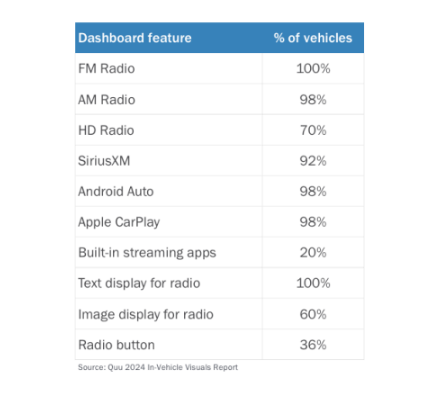Introducing a new study from the company bringing artwork and visual advertising and informational opportunities to radio broadcasters that provides station owners with a snapshot of AM and FM’s place in dashboard displays today.
Quu‘s 2024 In-Vehicle Visuals Report, a first-ever look that comes courtesy of the company founded by Chief Technology Officer Joe Harb and led by CEO Steve Newberry, is based on data collected by an independent contractor tasked with auditing in-dash systems in the nation’s 100 top-selling new vehicles.
To gauge radio’s in-dash standing, each vehicle audio entertainment system was carefully analyzed for listening features and visual components including radio text, artist, and song information. Photos were taken, and a detailed, standardized questionnaire was completed. Data was collected from individuals who sat in new vehicles onsite at various auto dealerships between November 2023 and January 2024.
“With so much listening happening in cars, we must identify our strengths and weaknesses,” Quu said. “This report intends to provide the broadcast industry with new research. As radio’s status evolves in future years, we will track it.
THE DASHBOARD SCORECARD
A snapshot of how common each feature is in the dashboard of the top 100 best-selling new vehicles in the U.S. is one of the key highlights of the inaugural In-Vehicle Visuals Report.
Six key findings were presented by Quu, all of which could be incorporated into a deck promoting broadcast radio’s benefits to advertisers:
- AM/FM radio is ubiquitous in new vehicles.
- AM/FM radio no longer has a dashboard monopoly.
- A growing number of vehicles offer built-in streaming apps.
- Two out of three new vehicles have HD Radio installed.
- GM vehicles are an exception to the widespread adoption of HD Radio.
- All new vehicles have in-dash text. Most can display logos and other images.
Of the above conclusions, the availability of HD Radio is perhaps a big eye-opener, as it was just a few years ago when getting digital multicast stations and/or “crystal clear HD Radio” was an add-on option for drivers who didn’t own a luxury automobile.
At the same time, General Motors’ lack of embrace of HD Radio is a matter Xperi Corp. will likely need to continue to resolve, some 20 years after HD Radio first appeared across the U.S.
Xperi SVP of Global Broadcast and Radio Joe D’Angelo is one of four industry experts working with Quu to analyze the results. “Despite sharing the dashboard with others, broadcast radio’s undeniably loyal audience will stay with them and spend more time with their programming if presented appropriately,” he said. “New connected car digital dashboards are unlocking tremendous opportunities for content curation.”
Also working with Quu as experts are Fred and Paul Jacobs and longtime radio industry programming consultant Mike McVay; independent broadcast radio researcher Doug Hyde is also involved in the project.
For Quu, the ability to have logos and images appear in-dash is a big plus.

Speaking with RBR+TVBR, Newberry notes that Quu is not selling the data detailing auto brand-by-auto brand dashboard details, and that it is designed for the industry to spark conversations with automotive companies while Quu gathers the information.
He also agrees with the contention that it is the fault of General Motors and not that of Xperi Corp. that HD Radio is virtually non-existent across GM’s automotive line.
Explaining why the report was created, Newberry recalls how some advertising clients, consumers and radio station managers were saying such things as, “I can’t see this,” or asking, “Is this working?”
“Nobody in the industry was looking at the dashboard,” Newberry says. “We wanted to ensure the industry had that yardstick and more than ‘instinctive feels.'”





